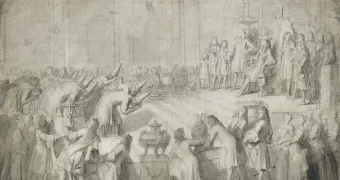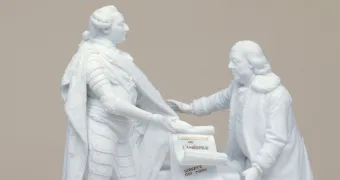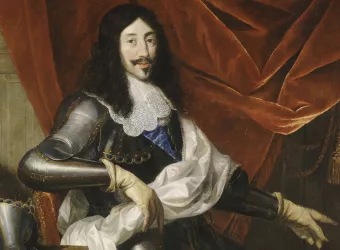Following the visits of the ambassadors of Genoa and Siam, the embassy of Persia was the third and final one to be received by Louis XIV in the Hall of Mirrors. The king had organised the ultimate demonstration of his splendour, but the embassy turned out to rather a rather puzzling one…

Reception of the Ambassadors of Persia, 1715 19 February 1715
At 11 am on 19 February 1715, Mohammed Reza Beg, Ambassador Extraordinary, entered the Palace gates on horseback, accompanied by his entourage, the Introducer of Ambassadors and the Lieutenant of the King’s Armies. A large crowd had filled Avenue de Paris and the courtyards to watch this exotic embassy arrive. In the Hall of Mirrors, four rows of tiered seats had been installed for the courtiers, only the most finely dressed of whom were allowed to enter. The hall was full of people, including a large number of foreigners. The king was on his throne at the end of the hall, along with the future Louis XV and his governess, Mme de Ventadour, flanked by the Duke of Orléans and the princes of the blood. Positioned at the foot of the platform to record the moment was the painter Coypel, along with Claude Gros de Boze, a scholar, numismatist and Secretary of the Académie des Inscriptions.
ANECDOTE
The reception of the ambassador of Persia provided inspiration for the Persian Letters by Montesquieu, written in 1721.
Louis XIV wanted to make an impact, and was dressed in black and gold bedecked with diamonds – garb worth an astronomical 12,500,000 Livres, and so heavily encrusted that right after dinner the king had to change. The rest of the royal family were similarly dressed. The Dauphin was also wearing an outfit covered with precious stones, while the Duke of Orléans wore embroidered blue velvet covered with pearls and diamonds, and the Duke of Maine and the Count of Toulouse, legitimated sons of the king, wore decorations of diamonds and pearls and precious stones.
The ambassador entered the gallery with an interpreter but, pretending to understand French, declared himself unhappy with the translation. A long audience with the king was followed by a dinner in his honour. After visiting the young Dauphin, whom he had become fond of, the mysterious Persian left Versailles.
The purpose of the ambassador’s visit is highly uncertain. Mohammed Reza Beg had arrived in Paris on 7 February but, according to Saint-Simon, brought no form of accreditation. The king believed he was an ambassador and received him, offering him accommodation in town with his First Valet de Chambre, Bontemps. His entourage was somewhat mediocre, as were his presents to the king, and some suspect that he was just a provincial official on a visit for his own pleasure. The king received him a second, and final, time on 13 August. This was his last diplomatic act.
Discover

Visitors' tales
The audience of the siamese embassy
Imagined from fragments and historical testimonies, this tale recounts the siamese embassy's journey to meet Louis XIV in 1686.

Visitors' tales
Mrs Thrale's visit to Versailles
Imagined from fragments and historical testimomies, discover the brillant Hester Thrale visiting teh court of Marie-Antoinette.

Visitors' tales
Benjamin Franklin's visit to Versailles
Imagined from fragments and historcal testimonies, this tale recounts the visit of Benjamin Franklin to Versailles in 1778.










